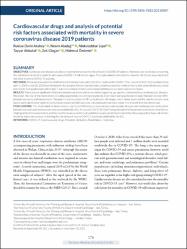| dc.contributor.author | Atabey, Rukiye Derin | |
| dc.contributor.author | Aladağ, Nesim | |
| dc.contributor.author | Şipal, Abdulcebbar | |
| dc.contributor.author | Akbulut, Tayyar | |
| dc.contributor.author | Doğan, Zeki | |
| dc.contributor.author | Özdemir, Mahmut | |
| dc.date.accessioned | 2022-12-19T10:34:35Z | |
| dc.date.available | 2022-12-19T10:34:35Z | |
| dc.date.issued | 2022 | en_US |
| dc.identifier.citation | Atabey, R. D., Aladağ, N., Şipal, A., Akbulut, T., Doğan, Z., & ÖzdemirM. (2022). Cardiovascular drugs and analysis of potential risk factors associated with mortality in severe coronavirus disease 2019 patients. Revista Da Associação Médica Brasileira, 68(2), pp.176–182. https://doi.org/10.1590/1806-9282.20210887
| en_US |
| dc.identifier.issn | 0104-4230 | |
| dc.identifier.issn | 1806-9282 | |
| dc.identifier.uri | WOS: 000767368200014 | |
| dc.identifier.uri | PubMed ID: 35239878 | |
| dc.identifier.uri | https://hdl.handle.net/20.500.12900/128 | |
| dc.description.abstract | OBJECTIVES: Cardiovascular diseases are also considered to increase the risk of death in COVID-19 patients. However, real-world data concerning
the risk factors for death in patients with severe COVID-19 still remain vague. This study aimed to identify the potential risk factors associated with
mortality in severe COVID-19 patients.
METHODS: All consecutive patients admitted to the intensive care unit (ICU) of our institute for COVID-19 for severe COVID-19 pneumonia from
April 1, 2020 to July 20, 2020 were included in the analysis. Patient characteristics, including complete medical history and comorbid diseases, blood
test results during admission and on day 7, and clinical characteristics were compared between survivors and nonsurvivors.
RESULTS: There was no significant difference between survivors and nonsurvivors regarding age, gender, and preexisting cardiovascular diseases.
Moreover, the rate of the medications including angiotensin-converting enzyme (ACE) inhibitor and angiotensin receptor blockers did not differ
between survivors and nonsurvivors. The peak C-reactive protein (CRP), procalcitonin, fibrinogen, and d-dimer levels and the rate for chronic renal
failure were significantly higher in nonsurvivors compared with survivors. Intubated patients had a higher risk of death than the others had.
CONCLUSIONS: This study failed to demonstrate a significant difference in preexisting cardiovascular diseases and cardiovascular medications
between survivors and nonsurvivors who were admitted to ICU for severe COVID-19. Our findings indicate that the presence of chronic renal failure,
a high peak ferritin concentration, and the need for invasive mechanical ventilation appear predictive for mortality. We propose that these risk factors
should be taken into account in defining the risk status of severe COVID-19 patients admitted to the ICU | en_US |
| dc.language.iso | eng | en_US |
| dc.publisher | Revista da Associação Médica Brasileira | en_US |
| dc.relation.isversionof | 10.1590/1806-9282.20210887 | en_US |
| dc.rights | info:eu-repo/semantics/openAccess | en_US |
| dc.subject | COVID-19 | en_US |
| dc.subject | Cardiovascular drugs | en_US |
| dc.subject | Potential risk factors | en_US |
| dc.subject | Renal failure. Intubation | en_US |
| dc.title | Cardiovascular drugs and analysis of potential risk factors associated with mortality in severe coronavirus disease 2019 patients | en_US |
| dc.type | article | en_US |
| dc.department | İstanbul Atlas Üniversitesi, Tıp Fakültesi, Dahili Tıp Bilimleri Bölümü | en_US |
| dc.authorid | Zeki Doğan / 0000-0002-5620-7268 | en_US |
| dc.contributor.institutionauthor | Doğan, Zeki | |
| dc.identifier.volume | 68 | en_US |
| dc.identifier.issue | 2 | en_US |
| dc.identifier.startpage | 176 | en_US |
| dc.identifier.endpage | 182 | en_US |
| dc.relation.publicationcategory | Makale - Uluslararası Hakemli Dergi - Kurum Öğretim Elemanı | en_US |

















